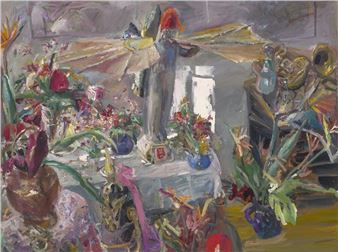Ibrahim Mahama: Vanishing Points 2014-2020
From dried fish skeletons to tattered jute sacks, Ibrahim Mahama salvages the discarded materials of commerce and daily life in Ghana to create monumental artworks. Sourcing materials from urban environments, his multilayered tapestries negotiate themes of commodity, migration, and economic exchange. Mahama assigns meaning to the ubiquitous and mundane as he constructs a complex archive of global history and its failures.
The artist is known for his large-scale architectural installations in which he drapes entire buildings - theatres, museums, and other monumental landmarks - in his trademark textile: salvaged jute sacks. Fabricated in South East Asia and used to distribute cocoa, coffee, rice, beans, and charcoal around the world, the sacks have multipurpose uses in their lifespan. Each sack is handled by countless weavers, packers and loaders, each marking the fabric with sweat, names, dates and coordinates. In collaboration with local workers, Mahama stitches these sacks together and creates colossal textile sculptures. The material is repurposed to critique the inequalities and exploitations inherent in capitalist and class structures.

Recommended for you
From dried fish skeletons to tattered jute sacks, Ibrahim Mahama salvages the discarded materials of commerce and daily life in Ghana to create monumental artworks. Sourcing materials from urban environments, his multilayered tapestries negotiate themes of commodity, migration, and economic exchange. Mahama assigns meaning to the ubiquitous and mundane as he constructs a complex archive of global history and its failures.
The artist is known for his large-scale architectural installations in which he drapes entire buildings - theatres, museums, and other monumental landmarks - in his trademark textile: salvaged jute sacks. Fabricated in South East Asia and used to distribute cocoa, coffee, rice, beans, and charcoal around the world, the sacks have multipurpose uses in their lifespan. Each sack is handled by countless weavers, packers and loaders, each marking the fabric with sweat, names, dates and coordinates. In collaboration with local workers, Mahama stitches these sacks together and creates colossal textile sculptures. The material is repurposed to critique the inequalities and exploitations inherent in capitalist and class structures.
















